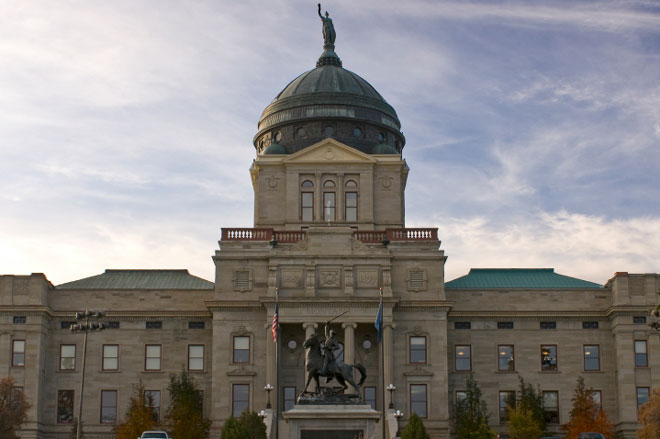News & Updates

Compulsory Attendance – Good or Bad?
I love the old saying “If it doesn’t fit, force it. If it breaks, it wasn’t meant to go there anyway”. Most men I know have jokingly shared that advice when they’re trying to fix something, they all know it’s a joke, not real advice. I only wish I could say the same for all of our legislators.
Montana’s public schools do a great job for most students, but there are some students who just don’t succeed. They fail classes, they get in trouble, or worse – they drop out. At the Montana Family Foundation, we want to help those students who are not succeeding in the traditional public school setting. We want to provide options to help them graduate. We want to make sure they can choose the system that will work for them rather than being forced into a one-size-fits-all program. What we don’t want to do is force them to stay in a system that isn’t working for them.
Which brings us back to the bad home repair advice I started with – when it comes to Montana’s kids, if it doesn’t work, please don’t force it! Yesterday, the Legislature considered a bill to ban students from dropping out until they’re 18. Currently the compulsory age is 16. We all want to fix the drop out problem, but shouldn’t we fix it by providing education options that work for kids, rather than requiring them to stay in a system that isn’t working?
If the system is failing a student, how is forcing him or her to stay in it longer going to help?
No student ever thinks, “Hey, this system is fine, I’m definitely learning, so I’ll just walk away.” No, they walk away because they’re not learning. Provide options that work and they won’t want to leave.
Not long ago, there was a Montana Family Foundation radio update where I talked about the definition of insanity: trying the same thing over and over again, and expecting different results. How much less sane is it to say, “I’m sorry this schools not working, but we won’t let you try anything different”. It’s like our schools are a bad parody of the song Hotel California: You can check out any time you want, but you can never leave. Sadly, the parody isn’t funny because too many students are checking out, and the establishment refuses to give them any option other than leaving.
Legislation making it illegal to leave school until you’re eighteen feels like the right idea. After all, dropping out of high school is a bad idea. When a student drops out of high school, they miss out on a lifetime worth of opportunities. But we can’t fix the problem by banning it. We can fix the problem by giving our students options and making the education system better.
The legislation that they should pass is legislation for school choice. Public charter schools can provide options that might help students who might otherwise drop out. We can make their school experience different, we can make it better, we can make it work.
How tragic that the education establishment hates that idea, they would rather try to solve the problem by taking the same system that isn’t working, and making it illegal to leave. If it isn’t working, it isn’t working. About half of the states of a compulsory attendance age of 18 and their graduation rates are no better than ours. One state actually lowered their compulsory attendance age from 18 to 16 and saw their graduation rates increase. Forcing kids to stay in a system that isn’t working is not a solution. It just prolongs the problem. Montana is one of only eight remaining states with no school choice. Maybe it’s time for a change.

Judges Who Make Laws
Last week at the legislature, the Chief Justice of the Montana Supreme Court addressed a joint session of the state House and Senate. He gave what is known as the “State of the Court” address. It probably won’t surprise anyone that he called for “an adequately funded judiciary.” At each Legislative session, it seems like half the people who give speeches call for spending more money.
Last week’s address is a great opportunity to observe how our system of separation of powers works. The Legislature, the Courts, and the Executive Branch are all independent, all powerful, and all have their own goals and their own purposes. When Montana’s courts want better funding, they must ask for it from the Legislative branch, and so must the executive. When the Legislature passes laws, they are enforced by the executive branch and interpreted by the judicial branch. When the Executive wants to propose a new program, he has to get it passed by the Legislature. Each branch has its own powers. Each is constantly seeking to expand its power, protect its territory from the others, and accomplish its goals.
That tension is by design. Our wise founders deliberately created a system that made it almost impossible to gather too much power together in one place. No one wants a Governor who can unilaterally proclaim what the law is – judge who’s guilty of breaking it, and throw them into prison. That’s just too much power for one person.
That’s why it’s such a problem when judges legislate from the bench. Legislating – or passing laws – is not properly something the judicial branch should do. In the American system, passing laws is the domain of the Legislature. For example, take the case of Roe vs. Wade, the court decision that legalized abortion. It was the court that made abortion legal in America. It wasn’t the Congress. It was a collection of judges who had never been elected by any member of the public who simply decreed one day that they believed the Constitution mandated that abortion be legalized.
Our great Republic isn’t supposed to work that way. Laws are supposed to represent the will of the people, and that’s why the Legislators who we vote for are the ones who should make laws, not the judges. It’s also why judicial races have become so contentious. The voters have realized that for all their talk of neutrality, judges still have a political worldview that they bring to the bench. Conservatives tend to judge more conservatively and liberals tend to judge more liberally. That’s just the way it is.
The crisis of the judicial branch usurping the role of the Legislative branch isn’t just a Montana issue. It stretches from the bottom all the way up to the U.S. Supreme Court. But it’s not something we have to accept. We get to vote for the President, who appoints Supreme Court justices. Here in Montana, we even get to vote for our state Supreme Court justices. And more important, we get to vote for our Legislators, who even now are deciding just how much money the court will have to spend.
The best thing for Montana families is to insist on judges who will never legislate from the bench. Whether you’re voting for the Governor, or Montana Supreme Court, or for Legislators who will write the budget for all-of- the above, find out where they stand on judges who make law. Only the ones who adhere to the separation of powers will make good judges for our families.

Who Has The Power?
Absolute power is worth nothing if you don’t know how to use it. It’s knowledge that creates power. And in Helena, you’d be surprised at who has the knowledge.
As I sit in my office, I see the lobbyists coming and going on their way to the Capitol building. They meet with Legislators, they brief staff, and the work with other lobbyists to plan the fate of bills and resolutions.
The faces of the lobbyists walking by are familiar to me. We’ve been working together for many years. Sometimes we’re on the same side of an issue. Sometimes we’re at loggerheads. Here’s what I can tell you about each one of these veteran lobbyists: they know their issues inside and out – and not just their issues. They know the process, the players, the rules and obscure strategies that have worked in the past. That’s because they’ve been here forever. Although new ones start every session, most lobbyists have been involved in the Legislative process for years, or even decades. That’s how they become experts. They work the same issues and policies year in and year out, and eventually everyone trusts them – which is one of the unintended consequences of term limits. While lobbyists are gaining expertise over decades, no legislator stays in the same chamber for even one decade.
Here in Montana, we have a citizen legislature. It meets only 90 days every other year. They don’t get paid to work 40 hour weeks, they don’t have staff helping out when the session’s over, and in the House of Representatives, most don’t even have their own offices. That means they have to have their own full time job. Our Legislators are farmers, teachers, homemakers, or salesmen who set aside their own livelihood for a few months in order to come to Helena to make laws. But when it comes to expertise on the issues, they’re caught in a bind. A salesman who studies an issue for 3 months can’t hope to know more than a lobbyist who has been working that issue for 30 years. That’s why I feel so strongly about the Montana Family Foundation having a presence here. In a world where lobbyists have all the knowledge, Montana families must have their share of the institutional memory as well.
If we just sit back and hope that our representatives will know the right thing to do, we can never hope to match the lobbyists who use their years of experience to push for abortion, or same-sex marriage, or worse. Only by having our own people who work just as long and just as hard can we be assured that our issues get a fair hearing. The goal of term limits was to keep those in government from getting stale and losing touch with the people. But like most laws, this one had an unintended consequence. It created a separate class, not quite the government but certainly not the private sector – a class who dominates the process and who knows the law like the back of their hands.
None of us have all the answers. I don’t know how to strike a balance between the importance of term limits and the problem of lobbyists knowing so much more than Legislators. But I do know this: knowledge is power, and the more we can share information with Montana families, the more powerful they will become.

We Don’t Need No Education – Really?
Every year somewhere between 1500 and 1600 students fail to graduate from high schools in Montana. But that’s okay, at least most of them graduated, right? Wrong! Most of us would say that’s completely unacceptable. Most of us would demand that those 1500 kids get as good an education as everyone else.
This week, Superintendent of Public Instruction Denise Juneau released her report on Montana’s public school dropout rates. For those of us who are policy wonks it makes fascinating reading! According to this report, “The economy of Montana would see a combination of crime-reduction savings and additional revenue of about $19.6 million each year if the male high school graduation rate increased by just 5 percent.” The report goes on to state, “Almost 30% of Montana’s high school dropouts meet the federal definition of low-income, which is twice the rate of high school graduates.”
My question is this, why aren’t we offering some options to those kids who drop out? Why don’t we give them the chance to try something different?
For the past two weeks the Montana education establishment has sent out press release after press release, raking the Montana Family Foundation over the coals because we support school choice. They’ve even gone so far as to say we want to destroy the public school system. Nothing could be further from the truth. We simply look at numbers like those mentioned above, declare them unacceptable and look for workable solutions. Montana is one of only eight remaining states with no school choice. Other states are leaving us in the dust and it’s time that changed.
Montana’s public schools serve most students just fine – 85 percent of them, according to the report. But there are unquestionably some students who are not being well-served. They’re in danger of dropping out, and it’s those students who are the best argument for school choice.
Seeing that nearly 15% of Montana high school students don’t successfully graduate in four years, there will be a certain faction in the legislature who will propose the same old solutions that have been tried for years in Montana:
“Put more money into the current system.”
“Force kids to stay in the current system longer.”
But there’s an old saying that the definition of insanity is doing the same thing over and over again and expecting different results. My question is, if we want real change in the lives of these kids, why not try something different? Why not try the solutions that are already working in other states?
On example is Public Charter Schools. They’re already working well in 42 states. If there’s a young man who’s failing in the public schools, and just needs a different environment, a charter schools could offer it to him.
The way charter schools work is that a group of citizens – maybe a trade union, a local community college or even a local public school district can gather together for the purposes of forming a school that works differently. They may focus on the arts or technology or the trades, but all provide a solid core curriculum. Once the new school passes all the important regulatory hurdles, the local school board can fund it and they can begin helping students succeed.
Charter schools have been tried in almost every other state in America, Presidents as different as George W. Bush and Barack Obama favor charter schools. Why? Because they work and they help kids. When 1500 to 1600 students regularly fail to graduate, it’s time to set aside ideology and special interest group politics. It’s time to stop doing the same thing over and over, and expecting different results.
It’s time to look for real solutions and alternatives, public charter schools would be a good place to start.

MHSA Threatens the Safety of Female Athletes
Do you want a six foot four, two hundred pound man spiking a volleyball at a sophomore girl? Of course not and last night the Laurel school board voted to send that message to the Montana High School Association. For those who haven’t heard, The MHSA will consider a major policy change at their next meeting on January 19th in Kalispell. Simply put, it would allow boys to play on girls sports teams. The actual language of the policy says “any individual whose gender identity does not match the sex assigned to him or her at birth to participate in the team sports of whatever gender with which they identify”.
This is crazy, and I still don’t know what “the sex assigned to him at birth” actually means. It’s not like the doctor flips a coin at birth before saying, “It’s a boy”! Setting aside their awkward language, the real meat of the problem is that it turns our daughters into victims of a politically correct solution in search of a problem. As the MHSA freely admits, this problem hasn’t occurred. But they want to pass their policy anyway. When they do, female student athletes will be at risk of losing their spots on sports teams, their college scholarships, and their privacy to a top-down regulatory scheme.
The MHSA meeting will be held next Monday at the Hilton Garden Inn, we encourage everyone who can get there to go and speak their mind. You can find out more about the meeting’s time and agenda, as well as rules regarding public participation by calling (406)442-6010.
This is one of those times when grassroots participation is crucial. If the only testimony that the MHSA hears is from the ACLU, they will adopt this policy or one like it. But if they hear from parents and students across Montana, the results could be very different. We need to show up! In Billings and Dillon, massive community participation saved their towns from so-called non-discrimination ordinances that violated religious freedom. The same effort can save our female student athletes from being victimized by this politically correct, top-down mandate.
This is a policy that Montana parents don’t want, and haven’t asked for. Its unintended consequences will reach far and wide into the world of student athletics, as scholarships, state records, locker rooms and showers all come into play. Most of all, as we said before, it’s a solution in search of a problem. No reports have been received of transgender students being denied a chance to participate in athletics. With no actual problems occurring and so much that can go wrong, the only common sense step for the MHSA is to step back, take a deep breath and think this through. I hope you’ll join me in praying that they’ll take a step that’s based purely on real-world practical decision-making, and say no to putting biological boys on girls’ teams.
The final change would require a two thirds vote of the MHSA member schools. Call your school board and ask them to follow Laurel’s lead. Ask them to vote no to the policy change. This is too important to slip by unchallenged. As I said, first contact your local school board and tell them this is a bad idea, then call the Montana High School association and tell them this is a bad idea, then plan to attend their meeting next Monday in Kalispell. Together we can keep Montana a safe place to raise our children and grandchildren.
